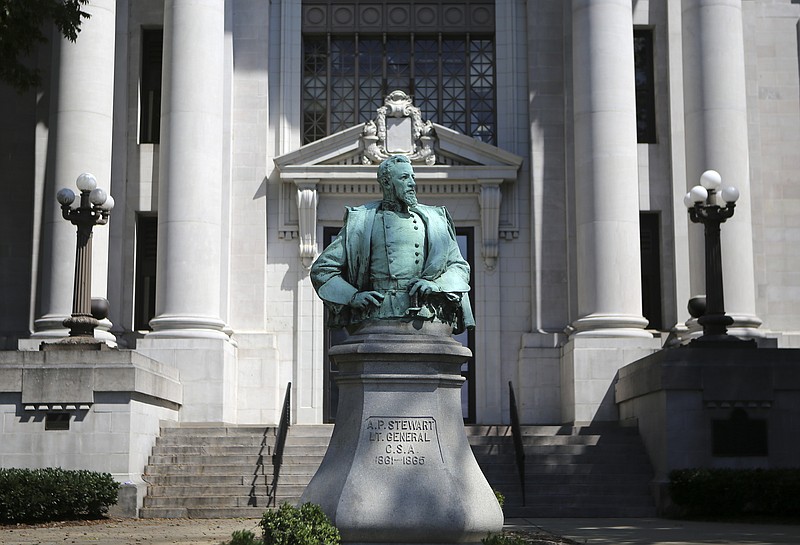Dear Commissioners of Hamilton County:
Old A.P. Stewart, the Confederate general whose bust is standing tired, lonely and besieged out there on the grounds of our county courthouse, has a message for you.
Take me down. Move me where I'll be more appreciated and at peace with my surroundings. Move me where I will no longer be used as a pawn by closet bigots and racists who don't realize they are racists and offend our diverse community today.
Or perhaps Old A.P., as he's usually known, might throw commissioners who still talk about bringing back their "discretionary" slush funds a bone: Put your money where your mouths are and spend some dollars to have a bust made of my co-military park commissioner - a former Union general - so that we may stand here together and be equal-opportunity reminders of our conflict-filled history and present.
Wednesday morning, our commissioners are expected to consider a resolution to relocate the Confederate bust of Gen. Alexander Peter Stewart after being presented a petition with about 1,100 signatures calling for the action.
Commissioners, here's your chance. Take a stand for unity and reconciliation. Or if you can't bear the thought of facing the wrath of white supremacists and misguided arm-chair historians who say this was a Confederate who was all about healing, then give Old A.P. the companionship of a similarly styled statue of Union Gen. Joseph S. Fullerton, who along with Stewart decades after the Civil War ended helped plan and build the Chickamauga and Chattanooga National Military Park to help bring national unity and to honor the soldiers of both sides.
But if you take no action other than to leave things as they are and stick your fingers into the eyes of those offended by the honor of a man who unequivocally thought Blacks were inferior, you must know that despite what the bust's defenders say, Stewart's likeness was never put there because he was instrumental in the nation's first military park.
Had that been the case, he would have been dressed in his civilian garb rather than Confederate uniform. And the wording on his statue would include mention of the park - not just his Confederate service.
You must know, too, that the A.P. Stewart Chapter of the Daughters of the Confederacy didn't name themselves after him or put him there in 1919 because he didn't own slaves. No, this group and indeed all of the chapters of the Daughters of the Confederacy had one mission: To keep alive the "lost cause" of an army that sought to overthrow our country so slaves would remain slaves. To further that intent, the Daughters funded and erected similar Confederate statues all over the South as a reminder to Blacks "of their place." It was intended, in the age of Jim Crow, to intimidate. Plain and in your face.
The Daughters did their own rewrite of history with their stated goal to "educate" white children about the "truth" of the War Between the States, according to Karen L. Cox, professor of history at the University of North Carolina at Charlotte and the author of "Dixie's Daughters: The United Daughters of the Confederacy and the Preservation of Confederate Culture."
It was the Daughters who opined "states' rights." But it was about those states' "rights" to perpetuate slavery.
One member even penned an influential school primer on the Ku Klux Klan as a fundraiser for the group. She later was lauded by that and other Confederate organizations for "bringing the true history of this great organization [the KKK] to the young people of the Southland, our boys and girls of today who will be our citizens of tomorrow," according to Cox.
They chose to honor Stewart, who wasn't even a Chattanooga son, because of his viewpoint on Blacks and his preferred social order.
Stewart's biographer, Sam Davis Elliott, described that viewpoint in "Soldier of Tennessee" as one of a "visceral belief in the inferiority of people of African descent and distaste for blacks' being on an equal social footing with whites."
So, commissioners, think twice before you vote again, as you did 6-2 in 2017, to leave Old A.P. standing at the Courthouse door.
Leaving him as he stands, your vote will not be seen as preserving history. It will be seen as preserving discrimination.
History can't be erased. Future discrimination can be.
